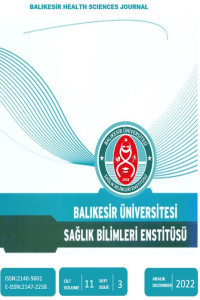Kanbay Sunum Değerlendirme Formu: Kuramsal Form Geliştirme Çalışması
Sunum Değerlendirme, Ölçek Geliştirme, Kuramsal Form Geliştirme
Kanbay Presentation Evaluation Form: A Theoretical Study of Form Development
Presentation evaluation, Scale development, Theoretical form development Sunum Değerlendirme, Ölçek Geliştirme, Kuramsal Form Geliştirme,
___
- REFERENCES Aktan, O. (2020). Determination of educational needs of teachers regarding the education of ınclusive students with learning disability. International Journal of Contemporary Educational Research, 7(1), 149–164. https://doi.org/10.33200/ijcer.638362.
- Batdı, V. (2013). İşbirlikli öğrenmenin yabancı dil öğretimindeki önemine ilişkin öğretmen görüşleri. Eğitim ve Öğretim Araştırmaları Dergisi, 2(1), 158–165.
- Baturay, M. H., Gökçearslan, Ş., & Ke, F. (2017). The relationship among pre-service teachers’ computer competence, attitude towards computer-assisted education, and intention of technology acceptance. International Journal of Technology Enhanced Learning, 9(1), 1–13.
- Czajka, C. D., & McConnell, D. (2019). The adoption of student-centered teaching materials as a professional development experience for college faculty. International Journal of Science Education, 41(5), 693–711. https://doi.org/10.1080/09500693.2019.1578908.
- Davis, L. L. (1992). Instrument review: Getting the most from a panel of experts. Applied Nursing Research, 5(4), 194–197. https://doi.org/10.1016/S0897-1897(05)80008-4.
- Döş, B. (2016). Analyzing the alternative assessment applications for the development of teaching: Review of literature. International Online Journal of Educational Sciences, 8(4), 215-228. http://dx.doi.org/10.15345/iojes. Ferizat, M., & Kuat, B. (2021). The effectiveness of interactive teaching methods in the professional training of pre-service geography teachers. Cypriot Journal of Educational Sciences, 16(4), 1976–1996. https://orcid.org/0000-0003-0193-3374.
- Grant, J. S., & Davis, L. L. (1997). Selection and use of content experts for instrument development. Research in Nursing & Health, 20(3), 269–274. https://doi.org/10.1002/(SICI)1098-240X(199706)20:3<269::AID-NUR9>3.0.CO;2-G.
- Köse, İ. A., Usta, H. G., & Yandı, A. (2016). Sunum yapma becerilerinin çok yüzeyli rasch analizi ile değerlendirilmesi. Abant İzzet Baysal Üniversitesi Eğitim Fakültesi Dergisi, 16(4), 1853-1864.
- Larson, S., Davis, L. E., Stevens, A. M., El-Ibiary, S., Grice, G., Pogge, E., Raney, E., & Storjohann, T. (2019). Development of a tool to assess and advance the effectiveness of preceptors: the habits of preceptors rubric. American Journal of Health-System Pharmacy, 76(21), 1762–1769. https://doi.org/10.1093/ajhp/zxz183.
- Lawshe, C. H. (1975). A quantitative approach to content validity. Personnel Psychology, 28(4), 563–575.
- Martins, J., Branco, F., Gonçalves, R., Au-Yong-Oliveira, M., Oliveira, T., Naranjo-Zolotov, M., & Cruz-Jesus, F. (2019). Assessing the success behind the use of education management information systems in higher education. Telematics and Informatics, 38, 182–193. https://doi.org/10.1016/j.tele.2018.10.001.
- Özbasi, D., & Arcagök, S. (2019). An İnvestigation of pre-service preschool teachers’ projects using the many-facet rasch model. International Journal of Progressive Education, 15(4), 157–173. https://doi.org/10.29329/ijpe.2019.203.12.
- Reddy, M. Y. (2011). Design and development of rubrics to improve assessment outcomes: A pilot study in a Master’s level business program in India. Quality Assurance in Education. 19(1) 84-104. https://doi.org/10.1108/09684881111107771.
- Şencan, H. (2005). Sosyal ve davranışsal ölçümlerde güvenilirlik ve geçerlilik, Seçkin Yayıncılık Sanayi ve Ticaret A. Ş., Ankara.
- Sumiyarrini, R., Rahayu, G. R., & Suhoyo, Y. (2017). Rubrik nursing clinical exercise: Pengembangan ınstrumen penilaian kompetensi klinis pada pendidikan klinik keperawatan. Jurnal Pendidikan Kedokteran Indonesia: The Indonesian Journal of Medical Education, 6(3), 194–205. https://doi.org/10.22146/jpki.32224.
- Tekalmaz, G., & Kezer, F. (2020). Development of a web-based environment for test and item statistics. Participatory Educational Research, 8(2), 147–162. https://doi.org/10.17275/per.21.34.8.2. Tekin, H. (2000). Eğitimde ölçme ve değerlendirme [Measurement and evaluation in education]. Ankara: Yargı Yayınevi.
- Tezbaşaran, A. A. (2008). Likert tipi ölçek hazırlama kılavuzu (3. Sürüm). Mersin: E-Kitap. Van Steenbrugge, H., Valcke, M., & Desoete, A. (2010). Mathematics learning difficulties in primary education: teachers’ professional knowledge and the use of commercially available learning packages. Educational Studies, 36(1), 59–71. https://doi.org/10.1080/03055690903148639.
- Yurdugul, H. (2005). Using content validity indexes for content validity in scale development studies. XIV. National Congress of Educational Sciences Denizli, 1–6.
- Yurdugül, H. (2019). http://yunus.hacettepe.edu.tr/~yurdugul/3/indir/FA_Orneklem Genislikleri.pdf.
- ISSN: 2146-9601
- Yayın Aralığı: Yılda 3 Sayı
- Başlangıç: 2012
- Yayıncı: Balıkesir Üniversitesi
Sağlık Uygulamalarında Sağlık İnancının Etkisi: Hemşirelerde El Hijyeni Örneği
Asli KURTGÖZ, Zehra İNCEDAL SONKAYA, Selin KESKİN
Çocuklarda Ağız Solunumu Sendromuna Bağlı Faktörlerin Değerlendirilmesi
Ceren İLİSULU, Kübra DOĞAN, Ceren CARLI, Figen SEYMEN
Tuğba MİSİLLİ, Özge Gizem CABADAĞ, Nazlı ÇETİN
Arteria Occipitalis’in Morfometrik Değerlendirilmesi
Emrah ÖZCAN, Esma DERİNÖZ, Bahar KEYİK, Ömür KARACA, Tuğba GİRGİN, İlter KUŞ, Alper VATANSEVER
Zeynep ÖZTÜRK, Meyreme AKSOY, Gülcan BAHÇECİOĞLU TURAN
Çocuk Hemşirelerinin Teknolojiye İlişkin Tutum ve Teknolojiyi Kullanma Durumlarının İncelenmesi
Dilek KONUKBAY, Kamer BABACAN, Dilek YILDIZ
Mesiya AYDIN, İlknur AYDIN AVCI
Gebelerin Kendilerini Algılaması ile Vajinal Doğum Öz-Yeterliliği Arasındaki İlişki
